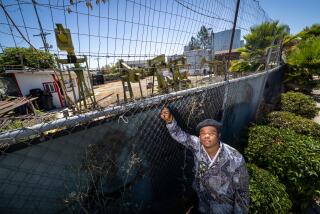A Minefield Fraught With Real Lessons
When Laguna Hills High students sold lollipops last year to raise money to remove land mines in distant war-torn places, the cause kept getting lost amid the candy.
“Kids were just buying the lollipops because they were lollipops, not for a cause,” said senior Lakshmi Ganesan, a member of the International Baccalaureate honors program that is sponsoring the campaign. “They didn’t understand or even care what we were doing with the money.”
That changed this year when the 37 honors students behind the fund-raising effort embarked on a mission to educate the school’s nearly 2,000 pupils on land mines.
The outreach appears to be working, with the money raised so far double last year’s $300 total. The students hope by June to collect at least $1,000 -- enough to fund the removal of one land mine or buy six prosthetic limbs.
The money goes to the nonprofit Landmine Survivors Network, based in Washington, D.C., which gives it to outreach centers in countries where land mines are buried.
The funds are spent on what officials at those centers see as the greatest need. The students eventually learn how their money was used.
Junior Elise Boivin, who taught one of the sessions, said the land mine issue is significant because it affects so many people, especially unsuspecting noncombatants.
“It isn’t just the people who live in the Third World countries,” she said. “It’s hikers, tourists -- land mines don’t discriminate. They kill regardless of who’s there.”
A land mine can remain active for decades after battles end. About 100 million land mines are buried and an additional 100 million stockpiled in 80 countries, according to the land mine network.
The effort to clear and ban land mines was most notably championed by the late Princess Diana. A video the Laguna Hills students show in class presentations features Diana cuddling a toddler who lost a leg to a land mine. Drafted in 1997, the Mine Ban Treaty has been signed by 146 countries. The United States, which has stockpiled 11 million mines and uses them to protect military personnel stationed between North and South Korea, is not among them.
International Baccalaureate is a rigorous two-year program in which students earn college credit while in high school. Originally created to provide standardized instruction for diplomats’ children, the program has been adopted by schools and emphasizes cultural exchange and international perspectives.
The international organization chooses an issue each year for students to work with while fulfilling their community service requirements. Land mine awareness is one of the few selected two years in a row.
Each of Laguna Hills’ International Baccalaureate students, who divided themselves into seven teaching groups, spent about a dozen hours preparing lessons, which included videos and maps furnished by the nonprofit land mine network.
Some seminars have featured a flashy PowerPoint presentation, a slide show of land mine survivors set to John Lennon’s “Imagine” and an activity in which students verbally steer blindfolded volunteers through an obstacle course of crumpled newspaper “land mines.”
Senior Daniel Shi said although he enjoyed watching his giggling classmates propel their glittery flip-flops, platform wedges and battered tennis shoes through the obstacle course, he understood the activity’s deeper message.
“It never occurred to me just how dangerous it was to walk through a minefield,” said Daniel, 17. “We were guiding each other and we still stepped on them. People who live by land mines are really taking chances with every step they take.”
Having students teach one another in a classroom setting is an uncommon component of the partnership between the nonprofit group and the International Baccalaureate program, said Christine Manula, who heads the land mine group’s advocacy department in the United States.
She has heard of students leading schoolwide assemblies and teachers incorporating information on land mines into lesson plans, but said the Laguna Hills approach is unusual.
“I think it’s great when schools take the extra step and go beyond the carwash or the bake sale,” Manula said. “Educating the next generation of activists about the issue is just as important as raising money.”
Most of the seminars, which by the end of the semester will have been given in all of the school’s 40-plus social studies classes, end with a quiz and a question-and-answer session. Students asked why it costs thousands of dollars to remove the mines -- different types of detecting devices are needed, and workers are given hazardous pay -- and how many people they affect each year.
Land mines maim or kill 10,000 civilians every year, junior Gillian O’Reilly said during a presentation to a sophomore world history class, noting that the figure comprises about one-third of Laguna Hills’ population.
Relating a worldwide problem to their suburban enclave, where half of the residents have college degrees and the median income is $70,000, has been one of the difficult parts of engaging students during the presentations, Lakshmi said.
“A lot of people in high school, especially in Orange County, live in a protective bubble,” she said. “We’re opening it up and making the whole student body realize we’re all part of a world community.”
More to Read
Sign up for Essential California
The most important California stories and recommendations in your inbox every morning.
You may occasionally receive promotional content from the Los Angeles Times.










